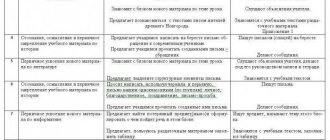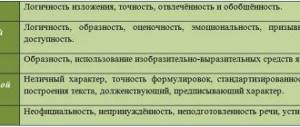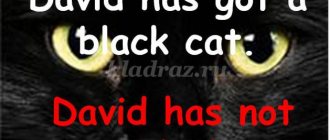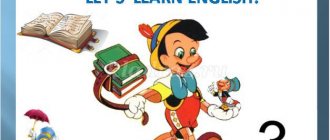The first steps into the amazing land of the English language should be exciting. After all, further learning is built on the basis of first impressions. That is why the first lesson should be given a lot of attention.
Tasks:
- Introduce forms of greeting and farewell, introductions (Hello, Good-bye, My name is).
- Teach to listen to the phrase “What's your name” and respond to it.
- Get interested in learning English.
Materials: Drawings for the fairy tale “Tongue”, Mickey Mouse - a toy.
Phonetic warm-up
To begin with, I want to tell you a fairy tale about the English language (obligatory accompaniment with illustrations in the first lessons). Each of us has a tongue in our mouth, this is its home.
There is a floor, a ceiling, walls, and even doors. (Be sure to clarify and show). Let's open and close the doors (open and close our mouths).
What does the tongue do? In his house he touched the floor, one wall, another and jumped onto the ceiling. But he has a favorite place - this is a slide behind his upper teeth. Let's get our tongues in there! Come on, jump on the hill !
The tongue loves to sing songs there: [lll], [la,la,la]. (draw the children’s attention that he sings not on his teeth, but on a slide.)
Also, our little tongue loves to read fairy tales. But he has to light a candle because it is very dark in his house. And when it’s time to go to bed, he puts out the candle like this: [hhh]
Little Tongue loves it when his house is clean, so he often knocks out the rug when he sits on the hill. Like this: .
Every day he ventilates his house, and the door slams from the wind. Like this: .
Suddenly it began to rain, and the tongue hid in the house, sat down on its favorite place, the hill, and listened to the rain dripping: .
Well done! Very well! (Very good)
Main stage
- And now we will fly on a magic carpet. Sit down on our magic carpet, please. Let's fly! (Children need to translate for the first time. In the future, you don’t have to do this, only if you have difficulty understanding, use the Russian translation again).
Teacher: What language do we speak?
Pupils: In Russian.
Teacher: Correct. Look at the map! Look at the map. We are in England . And here everyone speaks English. It is very different from our language, and if we want to communicate with the inhabitants of this country, then we must learn their language.
Let's fly! Now we have arrived in America , in the country where we made cartoons about Mickey Mouse and Winnie the Pooh. They also speak English. Where else do they speak this language? Do you want to know?
Let's fly! Now we have arrived in another country - Australia. Look at the picture! Look at the picture! This is a kangaroo! - This is a kangaroo. And it lives in Australia. Look at the map!
Teacher: What language do they speak in England? In which countries do they still speak English? Where does a kangaroo live? (children's answers) Good for you! Well done!
- Oh, children, look! Look! Mickey Mouse came to visit us from America. Let's talk to him! He whispered to me that he really wants to meet you, but he doesn’t know how to speak Russian. Let's learn how to say hello in English. And Mickey Mouse will help us with this.
Teacher: Hello, children! Let's say hello in English! Repeat after me.
Teacher + Pupils : Hello! Hello! Hello Mickey Mouse! How did we say hello? What did we say? (Individual answers from children).
- Physical education - just a minute. We are a little tired, let's rest. Mickey Mouse wants to teach you English exercises. Stand up, please. Stand up please.
Hands up! Hands down!
Hands on hips! Sit down!
Stand up! Hands to the sides!
Bend left! Bend right!
One, two, three, hop!
One, two, three, stop!
- It's time for Mickey Mouse to come home. He really enjoyed greeting you. You are so great. He promises to return to us. Now, let's say goodbye.
Teacher: Good-bye, children.
Teacher + Pupils Good-bye, Mickey Mouse!
Teacher + Once again all together: Good-bye, Mickey Mouse!
Summary of educational and game lessons in English for children 5-8 years old
Summary of educational and game lesson in English with preschoolers (primary schoolchildren) “Alina the Caterpillar and Her Friends” Lesson Plan “Aline-Caterpillar and Her Friends”
Author: Krikunova Irina Gennadievna, teacher of additional education, MAUDO "TsRTDU" MO "city of Buguruslan" Description of the material: I offer a synopsis of a cognitive-game lesson for children of senior preschool and primary school age. This summary can be useful for both teachers working with preschoolers and teachers teaching English in primary schools. Most of the lesson is taught in English, I practice the method of immersion in the language environment. Purpose of the lesson: development of speech skills. Objectives: Educational: to develop pronunciation skills, learn to establish contacts with a partner in playful communication situations, activate previously learned lexical and grammatical structures in children’s speech, in particular to use I have..., I can, repeat greeting and introduction formulas, learn to communicate about yourself, request information about what the interlocutor can do, talk about their skills, perform simple arithmetic operations (subtraction). Developmental: develop children's cognitive activity; develop auditory memory, attention, fine motor skills, develop the ability to think logically. Educational: cultivate a culture of communication, teach to listen carefully to your interlocutor, and answer questions politely. Equipment: transcription icons on cards, paper theater (caterpillar, frog, fish, cat, mouse, dog, rabbit, ladybug, bird, butterfly);
a backpack in the shape of a mouse, words and their transcription on yellow paper cut out in the shape of pieces of cheese; handout - coloring sheet with a rabbit depicted on it with examples for subtraction, TCO (computer or laptop for playing backing tracks for physical education, dice, chips, game “Ask and Answer”, prizes - pieces of processed cheese. Stages (Lesson progress)
I. Greeting.
Warming up activities. Org moment. Greetings. Teacher: Hello, children! Hello, children! Hello, children! Hello! Hello! Hello! Children: Hello, teacher!
Hello teacher! Hello teacher! Hello! Hello! Hello! II. Let's play the game “Who are you? What can you do?” Let's play the game “Who are you? What can you do?"
Teacher: Children, let's play the game called “Who are you?”
What can you do?” We have to stand in a circle. Take these nice paper animals. Sasha, take a dog. Maxim, take a rabbit. Ulyana, take a mouse. Lera, take a ladybird. Andrew, take a fish. Yana, take a frog. Alexandra, take a bird. What have you got, Sasha? (I've got a dog.) What have you got, Maxim? (I have got a rabbit.) The teacher gives the children animal toys from the fairy tale “Alina the Caterpillar and Her Friends”, the children stand in a circle. The teacher takes one toy, for example, Alina the caterpillar, and reminds that the question “Who are you?” in English it sounds like “Who are you?” The teacher repeats the question several times and asks the children to repeat after themselves. Then the teacher, “voicing” the caterpillar Alina, answers “I am a caterpillar.” Then he asks “What can you do?” The caterpillar replies “I can crawl.” Next, the caterpillar asks similar questions to the teacher. Then the turn goes to the children standing in a circle. Thus, children learn to ask for information about what the interlocutor can do and talk about their skills. In the process of working on the fairy tale, the children and I made all its characters and designed a poster, the main character on which consists of children’s handprints. III.
Let's play the game “English Sounds”. Let's repeat English sounds! Teacher: Children, I'll give you different English sounds, they are in brackets, they are transcription signs.
Your task is to raise your hand with the sound I pronounce. Be very attentive! The teacher gives each child a card with one or another transcription sign, for example, [h], [u:], [a:], [j], etc. Then the teacher calls the sound, and the child who holds the card with this sound picks it up and says the sound again. The game is aimed at developing auditory and visual memory, as children repeat transcription signs. IV.
Let's play the game “Feed the mouse!” Game “Let's feed the mouse!” Teacher: Children, who is there under the table? Children: It's a mouse! Teacher: The mouse is hungry! Let's feed the mouse! What does the mouse like eating? Children: Cheese! Teacher: Yes! That's right! But look, our cheese is magic, we have to match English words with their transcriptions. Only then we can feed the mouse. Clear? Children: Yes!
The teacher draws the children's attention to the fact that there is someone under the table.
They see a mouse. The teacher offers to feed him cheese. Words are written on half of the “pieces of cheese” made of colored paper, and the transcription to them is on the other half. The children’s task is to match the words with the transcription. Only in this case can you feed the mouse. Paired “pieces of cheese” fold a backpack in the shape of a mouse with the words “Help yourself!” V. Let's play the game “Solve some sums and color the rabbit!”
Let's play the game "Solve the examples and color the rabbit!" Teacher: Children, take these sheets of paper. Let's do the sums to know how to color the rabbit! If the answer is 0, color the space grey. If the answer is 1, color the space yellow. If the answer is 2, color the space green. If the answer is three, color the space blue. Pupil 1: six minus three is three. Pupil 2: one minus one is zero. Pupil 3: five minus three is two.
Etc. Children solve examples of addition and/or subtraction, pronounce their actions in English, for example, six minus two is four; five plus three is eight, etc. Then each element of the picture is painted with the appropriate color, following the key. If time is limited, you can only solve the examples in class and leave the coloring book as homework. VI.
Let's play the game "Typist". Let's play the game "Machinist". Teacher: Children, imagine that you are English letters, Andrew is letter B, Maxim is letter U, Kirill is letter T, Kamilla is letter T, Lera is letter E, Matvey is letter R, Alina is letter F, Yana is letter L , and Sasha is letter Y. And Alina is a typist. Listen to her and type her message on the magnetic board. Child: BUTTERFLY All children are given one of the letters that make up the word - BUTTERFLY - BUTTERFLY, one child is a driver, the teacher gives him a piece of paper on which the word butterfly is written, his task is to dictate the word letter by letter.
The rest of the children listen carefully. When their letter is called, they go to the magnetic board and stick it on the board. Then the resulting word is read in chorus and individually. You can make up several words familiar to children from the fairy tale “Alina the Caterpillar and Her Friends” by first changing the children’s letters. (The idea for this version of the game came thanks to the “Handbook for a Foreign Language Teacher.” Passov Efim I. Foreign Language Lesson / Passov E.I., Kuzovleva N.E. - Rostov n/D: Phoenix; M: Glossa-Press, 2010. ) VII.
Let's do morning exercises! Finger gymnastics “Caterpillar”. Teacher: Children, I'm sure you like doing exercises. It's very useful. Imagine that we are caterpillars. Aline-Caterpillar is a butterfly's daughter. She crawls very well and likes eating green leaves. Yum! Yum! Yum! Yum! Aline is full. She wants to sleep. Aline is sleeping. Wake up, wake up! Now Aline can fly Because she's a butterfly! Finger gymnastics “Caterpillar” Caterpillar, caterpillar, (the palm of one hand “crawls,” like a caterpillar, folding and unbending, along the inside of the other arm from the shoulder joint to the tip of the fingers) Butterfly’s daughter, (“crawls” back to the shoulder along the outside of the arm ) Crawling along the blades of grass (we do the same, changing hands: “from root to top”) Eats leaves: (and back on the other side) Am!
Am! Am! Am! (We put our palms together in front of us. With each word “Am!” one palm slides upward along the other palm and “bites” with all fingers, except the thumb, the straight fingers of the other palm. Then the palms change roles.) Ate - (we stop, palms folded together relax) I wanted to sleep. (One clenches into a fist, the other covers it - holds the fist like an apple) Woke up - (gradually straighten our palms) Turned into a butterfly! (we cross our hands at the wrists, our palms are now the wings of a butterfly) She flew, she flew, she flew! (we wave our “wings”: wrists or forearms are crossed, the left palm flaps near the right shoulder and vice versa). The author of the original finger gymnastics is Vera Aleksandrovna Orekhova https://kladraz.ru/blogs/vera-aleksandrovna-orekhova/-vesyolaja-gusenica.html VIII.
Let's play the game “Play and Say”. Game “Name the animal!” Teacher: Children, let's play. Your task is to throw the dice and move your counters. You should name the animals correctly, then you get one point. The winner is the pupil who can get 5 points faster than all the rest.
Children take turns throwing the dice and moving the chips.
Whoever correctly names the animal drawn in the box in English gets 1 point. The first one to score 5 points wins. (Blagoveshchenskaya T.A. Caterpillar Alina and her friends = Aline-Caterpillar and Her Friends. - M.: Iris-press, 2014. IX. Let's play the game “Ask and Answer”. Game “Ask and Answer”
Teacher: Kids , this game can help us learn how to read. You throw the dice and if you are on a red square, you should read and answer the question. If you are on a red square, you should just read the sentence (and translate it I'll help you if you ask for help.
Children take turns throwing the dice and moving the chips.
If the child lands on a red square, he reads the question and answers it. If a participant in the game lands on a yellow or green field, he reads the sentence (and translates it into Russian). The one who gets to the finish line faster wins. X. Setting homework.
Homework. Teacher: Dear boys and girls, at home you are to revise all English sounds, English Alphabet, read “Aline-Caterpillar and Her Friends” for pleasure.
XI.
Summing up. Saying goodbye. Summing up the lesson. Teacher: Dear children, thank you for your active work. Our lesson is over. Goodbye!
We recommend watching:
Outline of an English lesson on the topic: “Holidays in my country” for grade 6. Outline of an English lesson for 9th grade on the topic “Media” Outline of an English lesson in 10th grade Games in English lessons for preschoolers
Similar articles:
English lesson summary for grade 5 on the topic “Seasons”
English lesson notes, Pre-Intermediate level, teaching materials “Total English” A. Crace, Pearson Longman, 2011
Summary of an English lesson on the topic “Etiquette and manners of communicating on the telephone”






